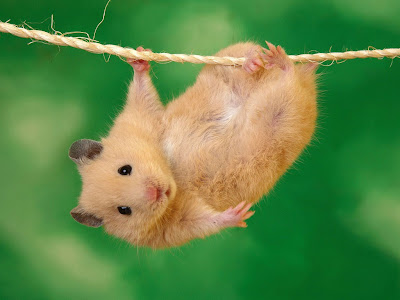Hamsters are rodents belonging to the subfamily Cricetinae. The subfamily contains about 25 species, classified in six or seven genera.
Hamsters are crepuscular. In the wild, they burrow underground in the daylight to avoid being caught by predators. Their diet contains a variety of foods, including dried food, berries, nuts, fresh fruits and vegetables. In the wild they will eat any wheat, nuts and small bits of fruit and vegetables that they might find lying around on the ground, and will occasionally eat small insects such as small fruit flies, crickets, and meal worms. They have elongated fur-lined pouches on both sides of their heads that extend to their shoulders, which they stuff full of food to be stored, brought back to the colony or to be eaten later.
Although the Golden Hamster (Mesocricetus auratus) was first described scientifically in 1839, it was not until 1930 that researchers were able to successfully breed and domesticate hamsters. Pet Syrian hamsters are descended from hamsters first found and captured in Syria by zoologist Israel Aharoni.
Hamster behaviour can vary depending on their environment, genetics, and interaction with people. Because they are easy to breed in captivity, hamsters are often used as lab animals in more economically developed countries. Hamsters have also become established as popular small house pets.
Hamsters are crepuscular. In the wild, they burrow underground in the daylight to avoid being caught by predators. Their diet contains a variety of foods, including dried food, berries, nuts, fresh fruits and vegetables. In the wild they will eat any wheat, nuts and small bits of fruit and vegetables that they might find lying around on the ground, and will occasionally eat small insects such as small fruit flies, crickets, and meal worms. They have elongated fur-lined pouches on both sides of their heads that extend to their shoulders, which they stuff full of food to be stored, brought back to the colony or to be eaten later.
Although the Golden Hamster (Mesocricetus auratus) was first described scientifically in 1839, it was not until 1930 that researchers were able to successfully breed and domesticate hamsters. Pet Syrian hamsters are descended from hamsters first found and captured in Syria by zoologist Israel Aharoni.
Hamster behaviour can vary depending on their environment, genetics, and interaction with people. Because they are easy to breed in captivity, hamsters are often used as lab animals in more economically developed countries. Hamsters have also become established as popular small house pets.
